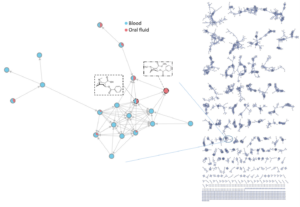
https://nij.ojp.gov/funding/awards/15pnij-21-gg-04171-coap
Recently, drug use patterns have changed and there has been a surge in novel psychoactive substance (NPS) use. As of December 2020, over 1,000 unique novel psychoactive substances have been reported to the United Nations Office on Drugs and Crime (UNODC) Early Warning Advisory. Rapid proliferation of NPS is at least in part driven by the desire to circumvent forensic detection. Untargeted screening of psychoactive substances in biological matrices is one of the most difficult yet exciting goals of forensic toxicology. Admittedly, truly untargeted screening is still out of reach. Recent interest in untargeted high resolution mass spectrometry (HRMS) is promising but still relies on targeted data processing, reference standard availability, and dereplication through spectral library matching. Computational algorithms are needed to mine untargeted mass spectral data and identify structural relationships and patterns without a spectral library. In pursuit of this, we propose leveraging open access molecular networking as a crowd-sourced spectral annotation strategy.
Molecular networking organizes mass spectral data to produce maps of component structural similarity without any prior knowledge of the sample’s composition. Our work includes developing and validating an untargeted sample preparation and screening method. Next, we generate a molecular network where spectra of compounds with structural similarity are clustered together. That molecular network is then seeded with known compounds through traditional spectral library matching. Molecular networking infrastructure is crowd-sourced so once new compounds are identified and validated, that information is immediately propagated through the entire molecular networking database. To facilitate adoption of molecular networking within the forensic toxicology community, are curating and making public a drug of abuse and metabolite spectral library within an open access platform. Furthermore, our datasets are made public for other research groups to build upon or annotate.
Funded by the National Institute of Justice, Research and Development in Forensic Science for Criminal Justice Purposes
- Award number: 15PNIJ-21-GG-04171-COAP
- Project Period: 1/1/22 – 12/31/24